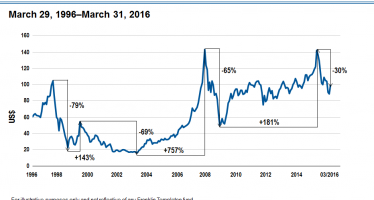Colombia on the mend

Direction of oil prices and the ability of the government to boost infrastructure spending remain biggest risks
Colombia is expected to face a challenging 2017, although potentially higher oil prices and a pick up in the pace of the country’s infrastructure program could improve its prospects.
“The outlook for Colombia will depend to some degree on the price of oil which is expected to rise and the government’s ability to aggressively push through its infrastructure program,”says Mark Mobius, Singapore-based executive chairman of Templeton Emerging Markets Group at Franklin Templeton Investments. He surmises that “if those two factors fall into place the outlook for Colombia will be good” but he believes “the market will be subdued in 2017.
In addition to higher oil prices, Christine Tan, chief investment officer with Excel Investment Counsel Inc. in Mississauga, Ontario also expects higher coal prices to benefit Colombia. With the largest coal reserves in Latin America, Colombia is one of the world’s biggest exporters; while oil accounts for approximately 40% of its total exports.
As well, says Tan, “the approval of a revised peace accord and ceasefire with the FARC (Revolutionary Armed Forces of Colombia) should be a longer-term positive although implementation might create some noise in the short term.”
In fact, last October Colombian voters rejected the peace accord crafted between the government and FARC, putting the peace process at risk.
Tan, however, cautions that “offsetting the positive developments in Colombia are high interest rates and relatively sluggish domestic growth as consumer sentiment remains muted.” The government increased interest rates to keep inflation in check, contributing to a pull-back in domestic demand.
The International Monetary Fund projects Colombia’s real GDP to grow by 2.7% in 2017, up from an estimated 2.2% in 2016. This is still well below the country’s average growth rate of 4.5% in the previous three years – largely due to lower oil prices.
To deal with its overexposure to the oil sector, the Colombian economy “is in transition to a new structural framework, with diversification away from energy sector dependence and US market dominance,” states Pablo Breard, vice-president and head of international economics at Scotiabank in Toronto, in the company’s October 17 outlook on Colombia. The country is in the process of establishing new markets to diversify trade and securing new sources of foreign direct investment.
From an investing standpoint, Tan notes that “Colombian equities are trading at approximately 11.3x forward consensus earnings, a slight discount to the MSCI Emerging Markets Index, versus expected earnings growth of approximately 16-18%.” Mobius notes that Colombian stocks are relatively cheap from a 5-year historical view “so there are bargains to be had for those investors willing to ride out the current uncertainties.”
He favours the consumer sector “because of its tendency to withstand economic problems” and “export-oriented companies because of the relatively weak Colombia Peso.”
On the other hand, Tan favours the country’s “infrastructure spending theme as Colombia is only at the beginning of a very ambitious US$70 billion infrastructure spending plan spanning up to 2035.” She says the government expects to add approximately 1.3% to 1.5% to GDP growth annually through infrastructure spending in projects ranging from four-lane highways to expansion of ports, airports and railways.
She likes Bancolombia S.A., the country’s main bank because financial penetration is still very low and the bank is experiencing improving net interest margins because of recent interest rate hikes; and has been focused on reducing costs but cautions that near-term credit quality concerns is impacting profitability.
She also likes Cementos Argos S.A., the largest cement company in Colombia. “With the strong infrastructure spending pipeline, the company is benefitting from an increase in cement prices and improving margins.”
In spite of its current challenges, Colombia remains one of the most business-friendly countries in Latin America, ranking number 2 in the region behind Mexico in the 2016 World Bank’s Ease of Doing Business Survey.
Canada’s Department of Foreign Affairs and International Trade notes that Canadian companies such as Talisman Energy and Pacific Rubiales are major investors in the country’s mining and energy sectors. In January, Brookfield Asset Management Inc. bought a majority stake in Isagen SA, Colombia’s largest hydropower plant, while in 2012, the Bank of Nova Scotia (BNS) bought a majority stake in Colfondos AFP, one of the country’s largest pension fund companies. Earlier, BNS bought a majority stake in the then fifth largest retail bank, Banco Colpatria.
In 2017, the direction of oil prices and the ability of the government to boost infrastructure spending are the biggest risks in Colombia, says Mobius. Tan notes that proposed tax reforms could also have a protracted negative impact on the economy. While insurgency risks are also an overhang, Tan “believes FARC shares the government’s intentions to maintain the peace accord and ceasefire although implementation might prove to take longer and be more complicated than expected.”
Incidentally, the proposed protectionist measures of US President-elect, Donald Trump, are not expected to have a negative impact on Colombia. “The Donald Trump presidency will be directed toward boosting the U.S. economy and by doing so will be positive for Colombia since the country’s exports to the U.S. should be enhanced, despite the talk of U.S. protectionism.” He adds “there are certain products such as coffee that Colombia produces, which would be hard to duplicate in the U.S. In addition, more prosperous U.S. companies will be willing to invest internationally including Colombia.”
Adds Tan: “since its export to the US is predominantly resource and not manufactured goods, we do not expect direct anti-trade actions against Colombia.”
( A version of this story first appeared in Investment Executive)
Dwarka Lakhan
Dwarka Lakhan is a pioneer in emerging markets journalism in Canada. His first emerging markets article, “Africa Joins Ranks of the Emerging,” appeared in Investment Executive, Canada’s leading newspaper for financial advisors, in September 1994. Since then he has written hundreds of articles on the full spectrum of emerging markets and has conducted more than two thousand interviews with emerging and frontier markets investment professionals.
Related Articles
We Still Don’t See a China Hard Landing
After a long period of outstanding economic growth, many investors are now wondering about the future path of China’s equity
EM can prove attractive for income investors
Once considered a niche asset class, emerging market (EM) bonds have become an attractive option for investors seeking higher yields
China and India: Two giants you can’t ignore
The meteoric rise of China and India as economic superpowers has permanently changed the global investment landscape. Though still considered



